|
Basic Coil Basketry
|
|
Coil basketry can be as simple or as ornate as you like. Techniques vary
quite a lot between cultures, and according to material choice, but also
how expedient you wish to make your bakset. The basket I show you how to
make in this article is simple kind which
doesn't take too long to make and can be made at home or
out in the woods. Such baskets would have been extremely useful and
important to our ancestors; because the coiled structure is so tight
these baskets are ideal for gathering, processing and storing seeds and
berries.
With the coiling technique you can make baskets of many shapes; vase
shaped, bottle shaped, or wide bowl shaped... A quick internet image
search for 'African coiled basketry' will reveal some extremely refined
and admirable examples.
The possibilities for material choice are vast.
I simply used hay and
inner Elm bark for the basket featured in the tutorial below; as that is
what I had to hand at the time. My favourite choice of material for the
main core of fibres would be Rushes or Sedges, I particularly like to
use the long fronds of Hard Rush or Pendulous Sedge. Pine needles, reeds
and many types of grass can also be excellent. Whatever you choose, if
the material is freshly cut from growing plants it's best to thoroughly
dry it first. Organic materials shrink a lot the first time they dry
out, so a basket made from fresh material will become all loose and poor
in quality when it dries out later.
For the binding material (which is
used to bind the layers of coils together) you could use flexible bark
fibres such as that from Elm, Willow and Lime; Modern string is
perfectly good too.
|
|
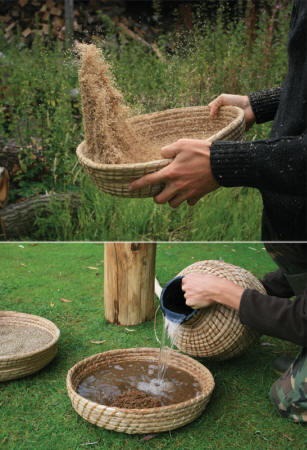 |
| |
|
|
|
| |
The Expedient Hay and Elm Bark Basket... |
|
|
|
|
|
|
To start the basket take a small handful
of hay and make the end into a piece of cord so
that you have an eye through which you can thread your binding material
(Elm bark in this case)
|
|
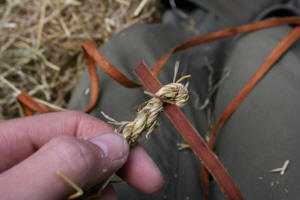 |
|
|
Begin to wrap the strip of bark around
the core of hay for a few centimetres. Gradually encourage this sausage
of material to begin to spiral around.
|
|
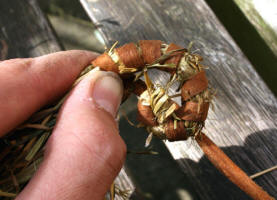 |
|
|
From now on
every couple of wraps you make with your binding material, take the end
and thread it under and around the previous layer of the coil. If you have trouble
threading between the layers you can use an awl to separate the
fibres.
With a fairly tough binding
material like this Elm bark you can point the end with your knife to
make it easier to thread between the layers. For a softer binding
material such as string I like to whittle a large wooden needle and use
this for threading. |
|
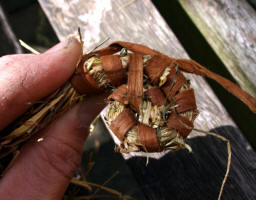 |
|
|
You will need to keep adding hay
into your fibre core to keep it an even thickness. The thickness of the
coil is up to you.
|
|
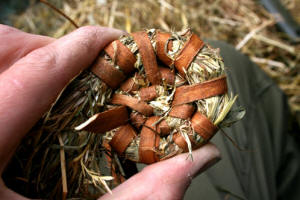 |
| |
|
|
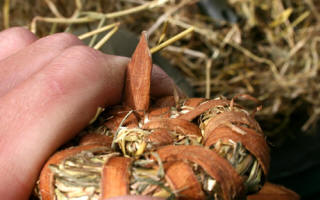 |
| |
When your bark strip is about to
run out you can weave/ thread the end down between the coils to lock it
in place. You can introduce new binding material by doing the same but
outwards towards the edge. |
|
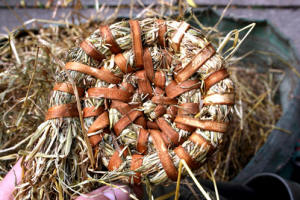 |
| |
|
|
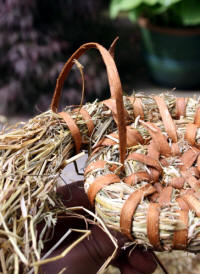 |
| |
|
|
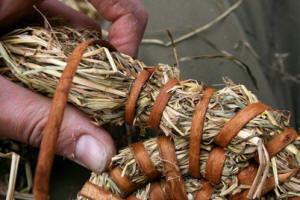 |
| |
It won’t be long before your basket has grown to a usable size. You can
make a basket as big or small as you like with walls as steep or gradual
as necessary depending on your needs.
|
|
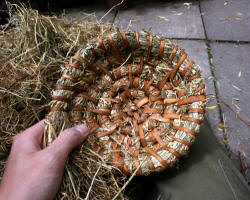 |
|
|
When you are happy with the size of
your basket stop adding in as much hay and eventually stop
altogether so that core of fibres tapers off.
|
|
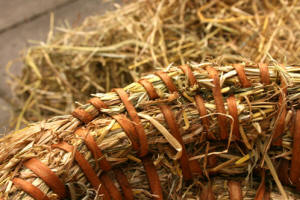 |
| |
You can make handles from various materials. A wooden
handle is rigid and strong which maybe suitable for your needs. The design
or use of a basket may mean that a handle is not required. |
|
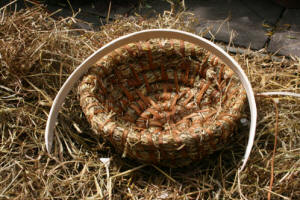 |
| |
For my basket I made this simple wooden handle from some
Willow. I have made a couple of wholes about 2 centimetres up from the
ends which I carved into points |
|
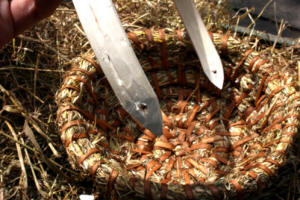 |
| |
Push the ends of the handle into the warp making sure that
the handle is central and straight. Now you will need to fix the handle in
place, this is where the wholes come in handy. |
|
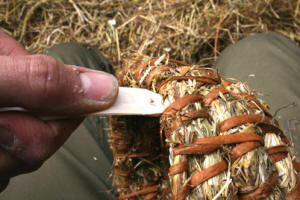 |
|
|
Push a thin stick or awl through the warp
fibers and whole, and then out the other side to separate the fibers. Now
pass string through this passage and tie the handle in place.
|
|
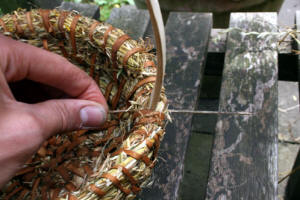 |
| |
|
|
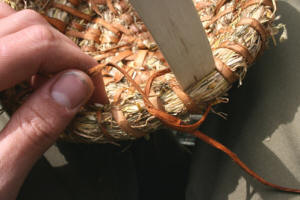 |
| |
I decided
to bind the top of the handle with bark to complete the basket. |
|
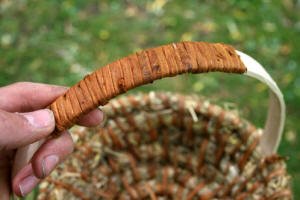 |
|
|
The two baskets shown here on the left
were made with hay and modern string. They have rope handles which were
made from hay too.
|
|
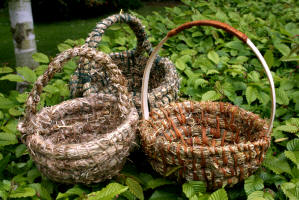 |
| |
These baskets are made from Sedges and is bound with inner
lime bark fibres. |
|
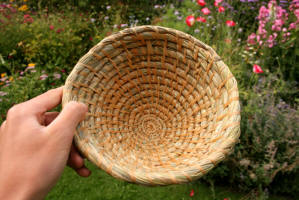 |
| |
This one uses a pine cone as a handle on the lid.
|
|
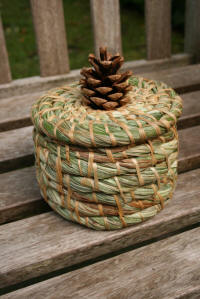 |
| |
|
|
|
